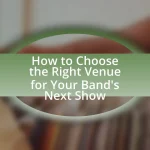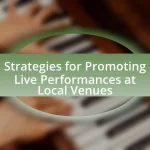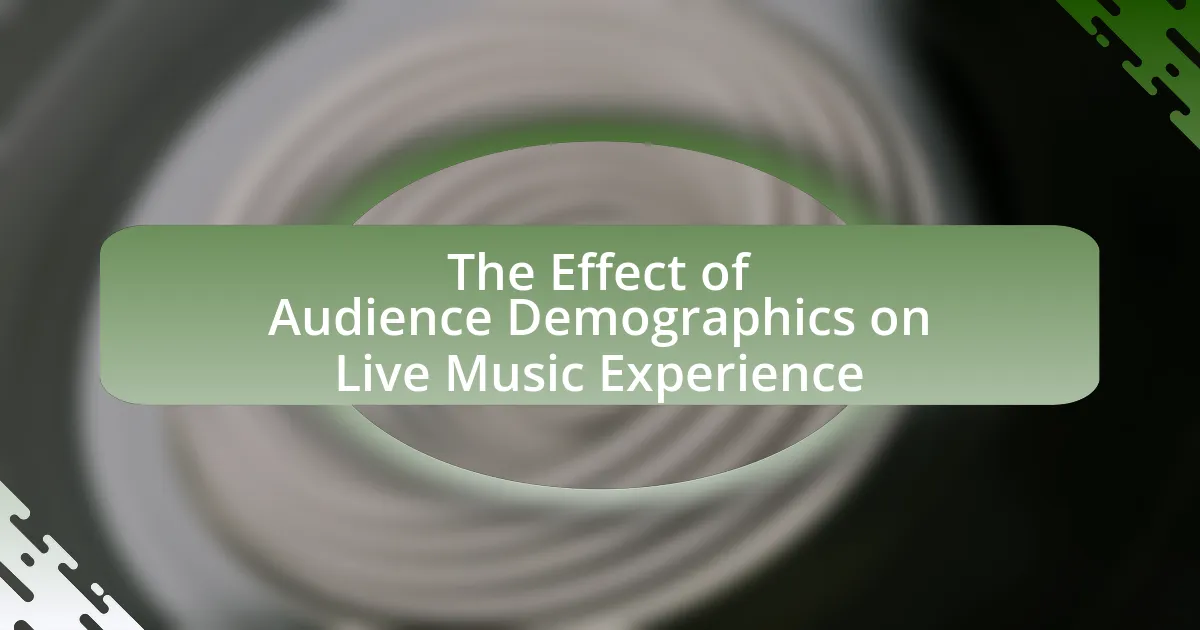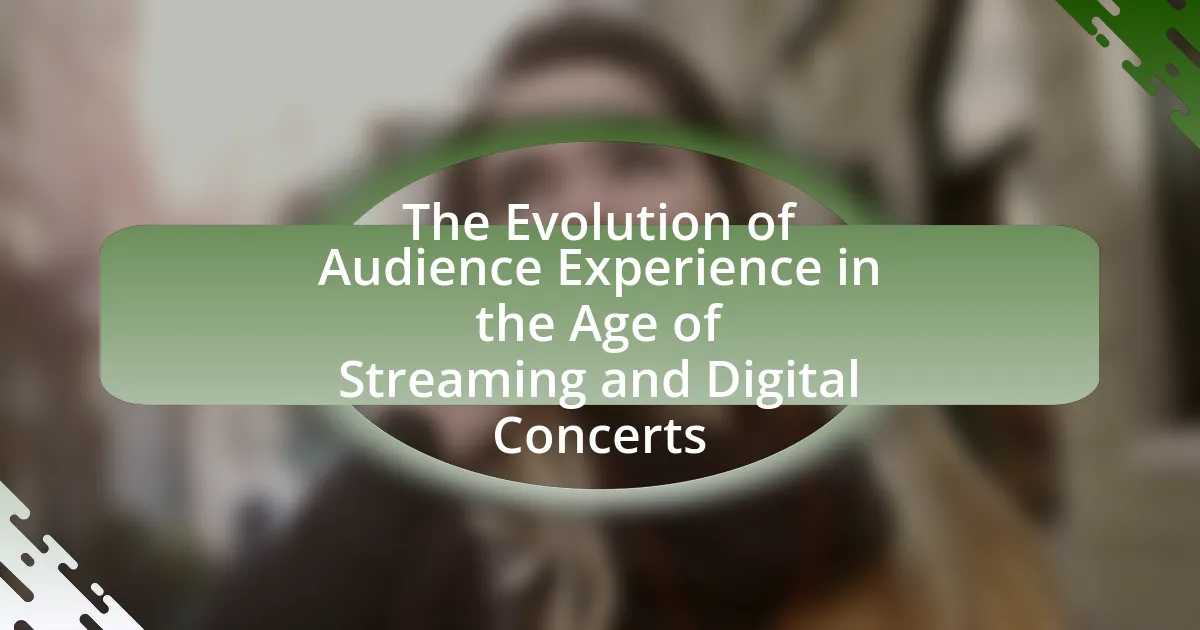Lighting design plays a crucial role in shaping audience mood at live music events by creating emotional atmospheres that enhance the overall experience. Key elements such as color, intensity, movement, and timing are essential in influencing audience emotions and engagement. Research indicates that well-coordinated lighting can amplify emotional responses, improve audience satisfaction, and foster a deeper connection to performances. The article explores how specific lighting choices affect emotions, the importance of audience mood, and the latest trends and technologies in lighting design that contribute to immersive experiences at live events.
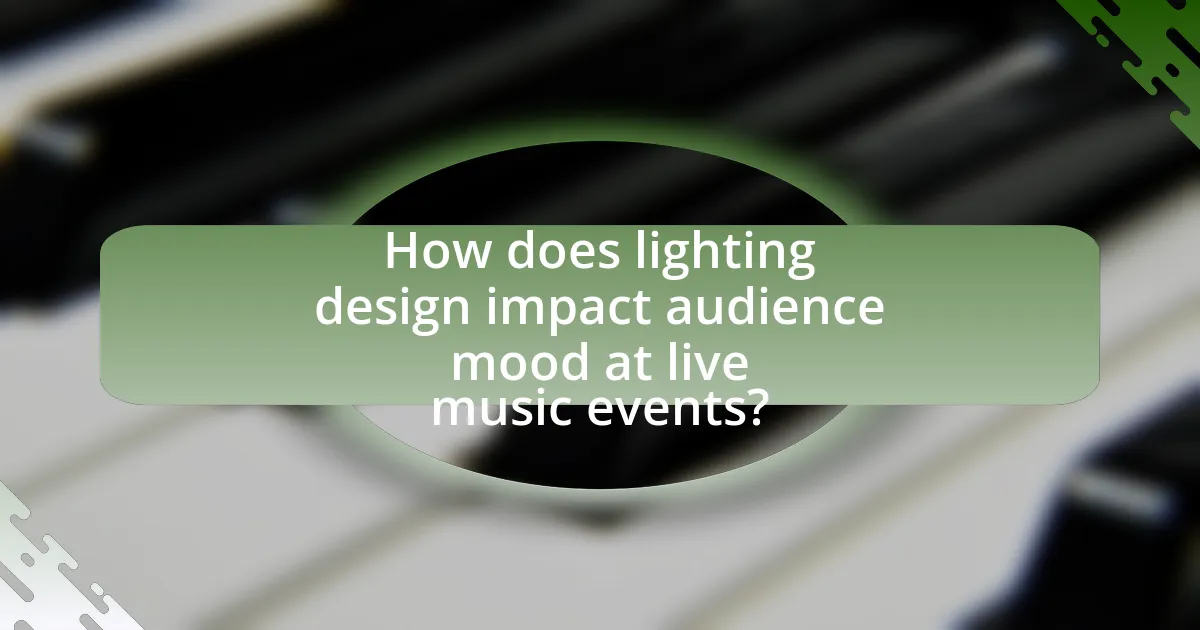
How does lighting design impact audience mood at live music events?
Lighting design significantly impacts audience mood at live music events by creating an emotional atmosphere that enhances the overall experience. The use of colors, intensity, and movement in lighting can evoke specific feelings; for instance, warm colors like red and orange can generate excitement, while cooler colors like blue and green can create a calming effect. Research indicates that synchronized lighting with music can amplify emotional responses, leading to increased engagement and enjoyment among attendees. A study published in the Journal of Environmental Psychology found that well-designed lighting can improve audience satisfaction and emotional connection to the performance, demonstrating the critical role of lighting in shaping the mood at live events.
What are the key elements of lighting design in live music events?
The key elements of lighting design in live music events include color, intensity, movement, and timing. Color influences the emotional tone of the performance; for example, warm colors can create an inviting atmosphere, while cool colors can evoke a sense of calm or sadness. Intensity affects visibility and focus, allowing certain performers or moments to stand out, which can enhance audience engagement. Movement, such as dynamic lighting changes or moving lights, adds excitement and can synchronize with the music, creating a more immersive experience. Timing is crucial for coordinating lighting changes with musical cues, ensuring that the visual elements complement the performance effectively. These elements work together to shape the audience’s emotional response, enhancing their overall experience at the event.
How do color choices in lighting affect audience emotions?
Color choices in lighting significantly influence audience emotions by evoking specific psychological responses. For instance, warm colors like red and orange can create feelings of excitement and energy, while cool colors such as blue and green tend to evoke calmness and tranquility. Research indicates that red lighting can increase heart rates and stimulate feelings of passion, as demonstrated in studies on color psychology, such as those conducted by Andrew Elliot and Markus Maier in 2014, which found that red enhances emotional arousal. Conversely, blue lighting has been shown to reduce anxiety and promote relaxation, making it effective in creating a soothing atmosphere. Thus, the strategic use of color in lighting design at live music events can profoundly shape the emotional experience of the audience.
What role does intensity and brightness play in setting the mood?
Intensity and brightness significantly influence the mood by affecting emotional responses and perceptions in live music events. High intensity and brightness can create an energetic and vibrant atmosphere, enhancing feelings of excitement and engagement among the audience. Conversely, lower intensity and dimmer lighting can evoke a more intimate or relaxed mood, fostering a sense of connection and introspection. Research indicates that specific lighting conditions can trigger psychological responses; for example, a study published in the Journal of Environmental Psychology found that bright lighting can increase arousal levels, while dim lighting can promote feelings of calmness and comfort. Thus, the careful manipulation of intensity and brightness in lighting design is crucial for shaping the overall emotional experience of the audience at live music events.
How does the timing of lighting changes influence audience reactions?
The timing of lighting changes significantly influences audience reactions by enhancing emotional engagement and creating dynamic experiences. When lighting transitions are synchronized with musical crescendos or key moments in a performance, they can amplify feelings of excitement or tension, leading to heightened audience responses. Research indicates that well-timed lighting can increase audience arousal and enjoyment, as demonstrated in studies where participants reported stronger emotional reactions during performances with coordinated lighting effects compared to those without. This synchronization fosters a deeper connection between the performers and the audience, ultimately enhancing the overall experience of live music events.
Why is audience mood important in live music events?
Audience mood is important in live music events because it directly influences the overall experience and engagement of attendees. A positive mood enhances emotional connection to the performance, leading to increased enjoyment and participation, while a negative mood can detract from the experience and reduce audience interaction. Research indicates that audience mood can be significantly affected by environmental factors, including lighting design, which can evoke specific emotions and set the tone for the event. For instance, studies show that warm lighting can create a welcoming atmosphere, fostering a sense of community among attendees, while cooler lighting may evoke feelings of excitement or intensity. Thus, understanding and managing audience mood through effective lighting design is crucial for maximizing the impact of live music events.
How does audience mood affect overall event experience?
Audience mood significantly affects overall event experience by influencing engagement, enjoyment, and emotional connection. When the audience is in a positive mood, they are more likely to participate actively, respond enthusiastically to performances, and create a vibrant atmosphere. Research indicates that positive emotional states enhance memory retention and satisfaction, leading to a more memorable experience. For instance, a study published in the Journal of Environmental Psychology found that well-designed lighting can elevate mood, thereby increasing audience enjoyment and participation levels at live events. This correlation demonstrates that audience mood, shaped by factors like lighting design, directly impacts the overall success and enjoyment of an event.
What psychological effects can lighting have on concert-goers?
Lighting can significantly influence the psychological state of concert-goers by enhancing emotional responses and shaping the overall experience. For instance, bright, dynamic lighting can elevate excitement and energy levels, while softer, dim lighting can create a more intimate and reflective atmosphere. Research indicates that specific colors and intensities of light can evoke distinct emotional reactions; for example, warm colors like red and orange are often associated with feelings of warmth and passion, while cooler colors like blue can induce calmness or sadness. A study published in the Journal of Environmental Psychology found that lighting conditions directly affect mood and behavior, demonstrating that well-designed lighting can enhance enjoyment and engagement during live performances.
How can lighting design enhance the performance of artists?
Lighting design can enhance the performance of artists by creating an immersive atmosphere that complements their artistic expression. Effective lighting can highlight key moments in a performance, drawing the audience’s attention to specific actions or emotions, thereby amplifying the overall impact. For instance, studies have shown that dynamic lighting changes can evoke emotional responses from the audience, which in turn can energize the performers and elevate their engagement. Additionally, well-designed lighting can improve visibility and focus, allowing artists to connect more deeply with their audience, ultimately leading to a more memorable and impactful performance.
What are the best practices for synchronizing lighting with music?
The best practices for synchronizing lighting with music include using beat detection technology, programming lighting cues to match musical transitions, and employing dynamic color changes that reflect the mood of the music. Beat detection technology analyzes the audio signal to trigger lighting changes in real-time, ensuring that the lights pulse in time with the rhythm. Programming lighting cues involves creating specific light changes that correspond to key moments in the music, such as drops or crescendos, enhancing the emotional impact of the performance. Additionally, dynamic color changes can be utilized to evoke specific feelings, aligning the visual experience with the auditory elements, which has been shown to significantly enhance audience engagement and mood during live events.
How does lighting design contribute to the storytelling aspect of a performance?
Lighting design significantly enhances the storytelling aspect of a performance by creating mood, emphasizing themes, and guiding audience focus. Through the strategic use of color, intensity, and movement, lighting can evoke specific emotions that align with the narrative, such as using warm tones to convey intimacy or cool hues to suggest tension. For instance, studies have shown that different colors can trigger emotional responses; blue light often induces feelings of calmness, while red can evoke excitement or urgency. Additionally, lighting transitions can signal changes in the storyline, helping to maintain the audience’s engagement and understanding of the plot. This interplay between lighting and narrative elements is crucial, as it not only supports the visual storytelling but also deepens the audience’s emotional connection to the performance.
What challenges do designers face in creating effective lighting for live music events?
Designers face several challenges in creating effective lighting for live music events, primarily including the need to balance artistic vision with technical limitations. The complexity of integrating lighting with live performances requires designers to consider factors such as venue size, audience sightlines, and the dynamic nature of music. For instance, lighting must enhance the performance without overwhelming the audience or detracting from the musicians. Additionally, designers must navigate the limitations of available technology, such as the brightness and color range of lights, while ensuring that the lighting complements the mood and energy of the music. These challenges are compounded by the need for real-time adjustments during performances, which requires a high level of coordination and communication among the production team.
How can technical limitations impact lighting design choices?
Technical limitations can significantly impact lighting design choices by restricting the types of lighting equipment and techniques that can be utilized. For instance, limitations in power supply may prevent the use of high-wattage fixtures, leading designers to opt for lower-intensity lights that may not achieve the desired atmospheric effects. Additionally, constraints in space can limit the placement and movement of lighting fixtures, affecting the overall visual dynamics of the performance. These factors can ultimately influence how effectively lighting can enhance audience engagement and mood during live music events, as the ability to create dramatic contrasts or subtle transitions may be compromised.
What strategies can be employed to overcome common lighting design challenges?
To overcome common lighting design challenges, employing a combination of adaptive lighting techniques, effective communication with the production team, and utilizing advanced lighting technology is essential. Adaptive lighting techniques, such as dynamic color changes and intensity adjustments, can enhance the mood and atmosphere of live music events, directly influencing audience engagement. Effective communication ensures that the lighting design aligns with the artistic vision of the performance, allowing for seamless integration with other production elements. Advanced lighting technology, including programmable LED systems and automated fixtures, provides designers with the flexibility to create complex lighting scenarios that can adapt to the evolving nature of live performances. These strategies collectively address challenges such as inconsistent lighting effects, audience visibility, and the need for quick adjustments during performances, thereby enhancing the overall experience for both performers and attendees.
What are the latest trends in lighting design for live music events?
The latest trends in lighting design for live music events include the use of LED technology, dynamic color mixing, and immersive visual experiences. LED technology allows for energy-efficient, versatile lighting that can create vibrant effects and intricate patterns, enhancing the overall atmosphere of the event. Dynamic color mixing enables lighting designers to adapt colors in real-time, responding to the music and audience reactions, which can significantly influence audience mood. Additionally, immersive visual experiences, such as projection mapping and synchronized light shows, engage audiences on multiple sensory levels, creating a more memorable and impactful experience. These trends reflect a shift towards more interactive and responsive lighting designs that prioritize audience engagement and emotional connection.
How is technology shaping the future of lighting design in concerts?
Technology is significantly shaping the future of lighting design in concerts by enabling more dynamic, interactive, and immersive experiences. Innovations such as LED technology, automated lighting systems, and software-driven design tools allow for precise control over color, intensity, and movement, enhancing the visual impact of performances. For instance, the use of DMX (Digital Multiplex) control systems facilitates synchronized lighting effects that can respond in real-time to music, creating a cohesive atmosphere that influences audience mood. Additionally, advancements in projection mapping and augmented reality are expanding the creative possibilities for lighting designers, allowing them to craft unique visual narratives that engage and captivate concert-goers. These technological developments not only elevate the aesthetic quality of live events but also play a crucial role in shaping the emotional responses of the audience.
What innovative techniques are being used to engage audiences through lighting?
Innovative techniques used to engage audiences through lighting include dynamic color changing, interactive light installations, and synchronized lighting with music. Dynamic color changing utilizes LED technology to create vibrant atmospheres that can shift in real-time, enhancing emotional responses. Interactive light installations allow audience participation, where movements or actions trigger lighting changes, fostering a deeper connection. Synchronized lighting with music creates a cohesive experience, as studies show that visual and auditory synchronization can amplify emotional engagement, making the overall experience more immersive.
What practical tips can enhance lighting design for live music events?
To enhance lighting design for live music events, utilize dynamic lighting techniques that adapt to the music’s tempo and mood. Implementing color changes that correspond with song themes can evoke specific emotions; for instance, warm colors like red and orange can create excitement, while cooler colors like blue and green can promote calmness. Research indicates that synchronized lighting can increase audience engagement by up to 30%, as it creates a more immersive experience. Additionally, incorporating moving lights and effects such as strobe or fog can add depth and excitement, further enhancing the overall atmosphere of the event.

